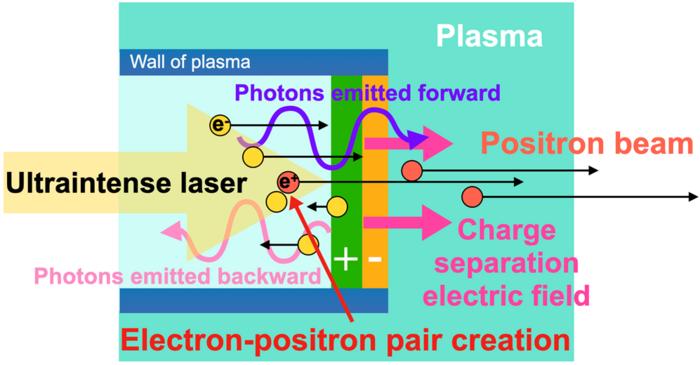Osaka, Japan – One of the most striking predictions of quantum physics is that matter can be generated solely from light (i.e., photons), and in fact, the astronomical bodies known as pulsars achieve this feat. Directly generating matter in this manner has not been achieved in a laboratory, but it would enable further testing of the theories of basic quantum physics and the fundamental composition of the universe.

Credit: Yasuhiko Sentoku
Osaka, Japan – One of the most striking predictions of quantum physics is that matter can be generated solely from light (i.e., photons), and in fact, the astronomical bodies known as pulsars achieve this feat. Directly generating matter in this manner has not been achieved in a laboratory, but it would enable further testing of the theories of basic quantum physics and the fundamental composition of the universe.
In a study recently published in Physical Review Letters, a team led by researchers at Osaka University has simulated conditions that enable photon–photon collisions, solely by using lasers. The simplicity of the setup and ease of implementation at presently available laser intensities make it a promising candidate for near-future experimental implementation.
Photon–photon collision is theorized to be a fundamental means by which matter is generated in the universe, and it arises from Einstein’s well-known equation E=mc2. In fact, researchers have indirectly produced matter from light: by high-speed acceleration of metal ions such as gold into one another. At such high speeds, each ion is surrounded by photons, and upon grazing past each other, matter and antimatter are produced. However, it is challenging to produce matter experimentally in modern laboratories through the sole use of laser light because of the extremely high-power lasers required. Simulating how this feat might be achieved in a laboratory could bring about an experimental breakthrough, so that’s what the researchers set out to do.
“Our simulations demonstrate that, when interacting with the intense electromagnetic fields of the laser, dense plasma can self-organize to form a photon–photon collider,” explains Dr Sugimoto, lead author of the study. “This collider contains a dense population of gamma rays, ten times denser than the density of electrons in the plasma and whose energy is a million times greater than the energy of the photons in the laser.”
Photon–photon collisions in the collider produce electron–positron pairs, and the positrons are accelerated by a plasma electric field created by the laser. This results in a positron beam.
“This is the first simulation of accelerating positrons from the linear Breit–Wheeler process under relativistic conditions,” says Prof Arefiev, co-author of UCSD. “We feel that our proposal is experimentally feasible, and we look forward to real-world implementation.” Dr Vyacheslav Lukin, a program director at the US National Science Foundation which supported the work, says “This research shows a potential way to explore the mysteries of the universe in a laboratory setting. The future possibilities at today’s and tomorrow’s high-power laser facilities just became even more intriguing.”
Applications of this work to the fictional matter–energy conversion technology of Star Trek remain just that: fiction. Nevertheless, this work has the potential to help experimentally confirm theories of the composition of the universe, or perhaps even help discover previously unknown physics.
###
The article, “Positron generation and acceleration in self-organized photon collider by ultra intense laser pulse,” was published in Physical Review Letters at DOI: https://journals.aps.org/prl/abstract/10.1103/PhysRevLett.131.065102
About Osaka University
Osaka University was founded in 1931 as one of the seven imperial universities of Japan and is now one of Japan’s leading comprehensive universities with a broad disciplinary spectrum. This strength is coupled with a singular drive for innovation that extends throughout the scientific process, from fundamental research to the creation of applied technology with positive economic impacts. Its commitment to innovation has been recognized in Japan and around the world, being named Japan’s most innovative university in 2015 (Reuters 2015 Top 100) and one of the most innovative institutions in the world in 2017 (Innovative Universities and the Nature Index Innovation 2017). Now, Osaka University is leveraging its role as a Designated National University Corporation selected by the Ministry of Education, Culture, Sports, Science and Technology to contribute to innovation for human welfare, sustainable development of society, and social transformation.
Website: https://resou.osaka-u.ac.jp/en
Journal
Physical Review Letters
DOI
10.1103/PhysRevLett.131.065102
Method of Research
Computational simulation/modeling
Subject of Research
Not applicable
Article Title
Positron generation and acceleration in a self-organized photon collider enabled by an ultra-intense laser pulse
Article Publication Date
9-Aug-2023




